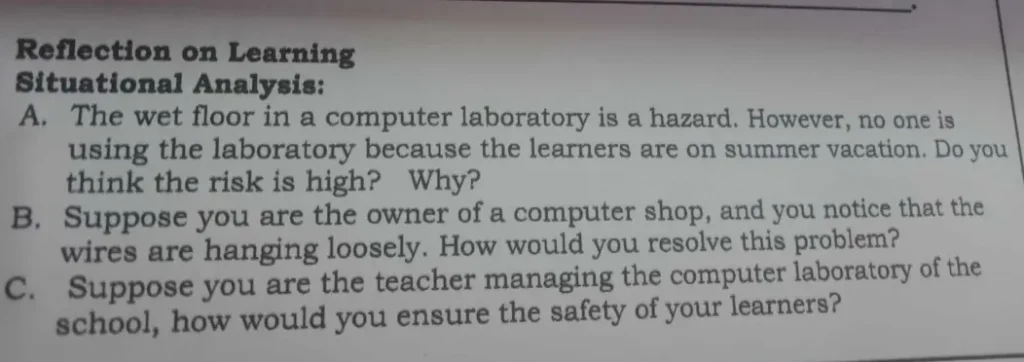Homework Help: Questions and Answers: Reflection on Learning Situational Analysis:

A. The wet floor in a computer laboratory is a hazard. However, no one is using the laboratory because the learners are on summer vacation. Do you think the risk is high? Why?
B. Suppose you are the owner of a computer shop, and you notice that the wires are hanging loosely. How would you resolve this problem?
C. Suppose you are the teacher managing the computer laboratory of the school, how would you ensure the safety of your learners?
Answer:
Let’s break down and address each question step by step.
A: Wet floor in a computer laboratory
Q: The wet floor in a computer laboratory is a hazard. However, no one is using the laboratory because the learners are on summer vacation. Do you think the risk is high? Why?
Assessment of Risk:
- Hazard: The wet floor is a potential hazard because it could cause slips, trips, or falls, which might result in injuries.
- Current Situation: Since the laboratory is not in use (learners are on summer vacation), the immediate risk of injury is low.
Consideration:
- Potential for Future Risk: While the current risk is low due to the absence of people, the risk will become high once the laboratory is in use again.
- Maintenance: If the wet floor is not addressed during the vacation period, it could cause damage to the equipment, leading to further hazards and financial losses.
Conclusion:
- Immediate Risk: Low, because no one is present.
- Potential Risk: High, because if left unresolved, it could pose significant risks when the laboratory is in use again.
B: Computer Shop Owner Scenario
Q: Suppose you are the owner of a computer shop, and you notice that the wires are hanging loosely. How would you resolve this problem?
Identify the Problem: Loose wires pose several risks, including tripping hazards, potential electrical shorts, and damage to the equipment.
Steps to Resolve:
- Immediate Action: Unplug any devices connected to the loose wires to prevent electrical accidents.
- Organize the Wires: Use cable management tools such as zip ties, cable clips, or cable sleeves to secure the wires and keep them neatly organized.
- Secure Wires: Attach the wires to walls, desks, or other surfaces to ensure they don’t hang loosely.
- Inspect for Damage: Check the wires for any wear and tear. Replace any damaged wires to prevent electrical hazards.
- Regular Maintenance: Establish a routine to regularly check and organize wires to prevent future problems.
C: Teacher Managing a Computer Laboratory
Q: Suppose you are the teacher managing the computer laboratory of the school, how would you ensure the safety of your learners?
Initial Safety Assessment:
- Inspect the Laboratory: Regularly inspect the laboratory for any potential hazards such as wet floors, exposed wires, or faulty equipment.
- Ensure Proper Ventilation and Lighting: Make sure the lab is well-ventilated and adequately lit to prevent eye strain and overheating of equipment.
Establish Safety Protocols:
- Create Safety Guidelines: Develop clear safety guidelines and ensure that all students are aware of them.
- Training: Conduct training sessions to teach students how to safely use the equipment, handle electrical devices, and respond to emergencies.
- Supervision: Always supervise students while they are in the laboratory to ensure they are following safety protocols.
Emergency Preparedness:
- Emergency Equipment: Ensure that fire extinguishers, first aid kits, and emergency exits are easily accessible.
- Drills: Conduct regular emergency drills so that students know how to respond in case of an emergency.
Regular Maintenance:
- Routine Checks: Schedule regular maintenance of all equipment to ensure everything is in good working order.
- Prompt Repairs: Address any issues immediately to prevent accidents.
Documentation:
- Record Keeping: Keep detailed records of all inspections, maintenance activities, and any incidents that occur in the laboratory.
By following these steps, you can effectively manage the safety of learners in a computer laboratory.
Learn More: Homework Help
Q. To financially analyze engineering projects, we need to model the projects in terms of:
Q. What is important to Cybunnies, according to Cybunny Rules 101?
Q. Which of the following best describes “3D Generative Adversarial Networks (3D GANs)”?

